PNG格式介绍
- 格式:ppt
- 大小:285.50 KB
- 文档页数:11
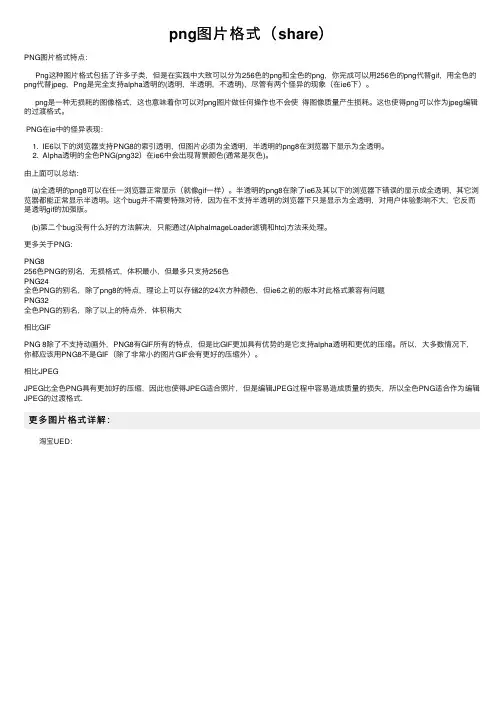
png图⽚格式(share)PNG图⽚格式特点:Png这种图⽚格式包括了许多⼦类,但是在实践中⼤致可以分为256⾊的png和全⾊的png,你完成可以⽤256⾊的png代替gif,⽤全⾊的png代替jpeg,Png是完全⽀持alpha透明的(透明,半透明,不透明),尽管有两个怪异的现象(在ie6下)。
png是⼀种⽆损耗的图像格式,这也意味着你可以对png图⽚做任何操作也不会使得图像质量产⽣损耗。
这也使得png可以作为jpeg编辑的过渡格式。
PNG在ie中的怪异表现:1. IE6以下的浏览器⽀持PNG8的索引透明,但图⽚必须为全透明,半透明的png8在浏览器下显⽰为全透明。
2. Alpha透明的全⾊PNG(png32)在ie6中会出现背景颜⾊(通常是灰⾊)。
由上⾯可以总结:(a)全透明的png8可以在任⼀浏览器正常显⽰(就像gif⼀样)。
半透明的png8在除了ie6及其以下的浏览器下错误的显⽰成全透明,其它浏览器都能正常显⽰半透明。
这个bug并不需要特殊对待,因为在不⽀持半透明的浏览器下只是显⽰为全透明,对⽤户体验影响不⼤,它反⽽是透明gif的加强版。
(b)第⼆个bug没有什么好的⽅法解决,只能通过(AlphaImageLoader滤镜和htc)⽅法来处理。
更多关于PNG:PNG8256⾊PNG的别名,⽆损格式,体积最⼩,但最多只⽀持256⾊PNG24全⾊PNG的别名,除了png8的特点,理论上可以存储2的24次⽅种颜⾊,但ie6之前的版本对此格式兼容有问题PNG32全⾊PNG的别名,除了以上的特点外,体积稍⼤相⽐GIFPNG 8除了不⽀持动画外,PNG8有GIF所有的特点,但是⽐GIF更加具有优势的是它⽀持alpha透明和更优的压缩。
所以,⼤多数情况下,你都应该⽤PNG8不是GIF(除了⾮常⼩的图⽚GIF会有更好的压缩外)。
相⽐JPEGJPEG⽐全⾊PNG具有更加好的压缩,因此也使得JPEG适合照⽚,但是编辑JPEG过程中容易造成质量的损失,所以全⾊PNG适合作为编辑JPEG的过渡格式.更多图⽚格式详解: 淘宝UED:。
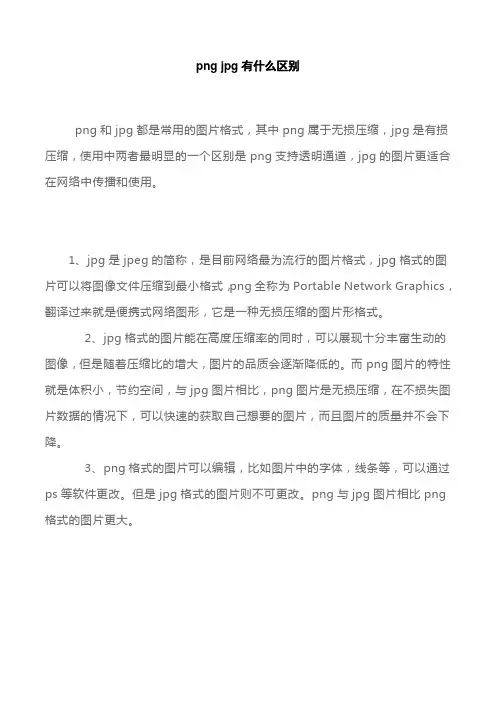
png jpg有什么区别
png和jpg都是常用的图片格式,其中png属于无损压缩,jpg是有损压缩,使用中两者最明显的一个区别是png支持透明通道,jpg的图片更适合在网络中传播和使用。
1、jpg是jpeg的简称,是目前网络最为流行的图片格式,jpg格式的图片可以将图像文件压缩到最小格式,png全称为Portable Network Graphics,翻译过来就是便携式网络图形,它是一种无损压缩的图片形格式。
2、jpg格式的图片能在高度压缩率的同时,可以展现十分丰富生动的图像,但是随着压缩比的增大,图片的品质会逐渐降低的。
而png图片的特性就是体积小,节约空间,与jpg图片相比,png图片是无损压缩,在不损失图片数据的情况下,可以快速的获取自己想要的图片,而且图片的质量并不会下降。
3、png格式的图片可以编辑,比如图片中的字体,线条等,可以通过ps等软件更改。
但是jpg格式的图片则不可更改。
png与jpg图片相比png 格式的图片更大。

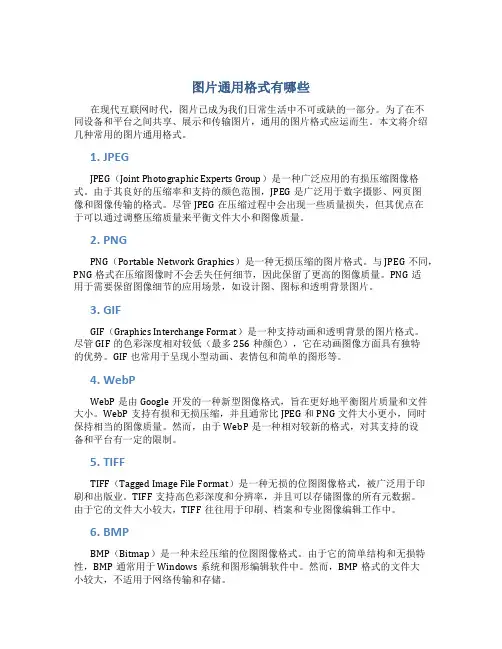
图片通用格式有哪些在现代互联网时代,图片已成为我们日常生活中不可或缺的一部分。
为了在不同设备和平台之间共享、展示和传输图片,通用的图片格式应运而生。
本文将介绍几种常用的图片通用格式。
1. JPEGJPEG(Joint Photographic Experts Group)是一种广泛应用的有损压缩图像格式。
由于其良好的压缩率和支持的颜色范围,JPEG是广泛用于数字摄影、网页图像和图像传输的格式。
尽管JPEG在压缩过程中会出现一些质量损失,但其优点在于可以通过调整压缩质量来平衡文件大小和图像质量。
2. PNGPNG(Portable Network Graphics)是一种无损压缩的图片格式。
与JPEG不同,PNG格式在压缩图像时不会丢失任何细节,因此保留了更高的图像质量。
PNG适用于需要保留图像细节的应用场景,如设计图、图标和透明背景图片。
3. GIFGIF(Graphics Interchange Format)是一种支持动画和透明背景的图片格式。
尽管GIF的色彩深度相对较低(最多256种颜色),它在动画图像方面具有独特的优势。
GIF也常用于呈现小型动画、表情包和简单的图形等。
4. WebPWebP是由Google开发的一种新型图像格式,旨在更好地平衡图片质量和文件大小。
WebP支持有损和无损压缩,并且通常比JPEG和PNG文件大小更小,同时保持相当的图像质量。
然而,由于WebP是一种相对较新的格式,对其支持的设备和平台有一定的限制。
5. TIFFTIFF(Tagged Image File Format)是一种无损的位图图像格式,被广泛用于印刷和出版业。
TIFF支持高色彩深度和分辨率,并且可以存储图像的所有元数据。
由于它的文件大小较大,TIFF往往用于印刷、档案和专业图像编辑工作中。
6. BMPBMP(Bitmap)是一种未经压缩的位图图像格式。
由于它的简单结构和无损特性,BMP通常用于Windows系统和图形编辑软件中。
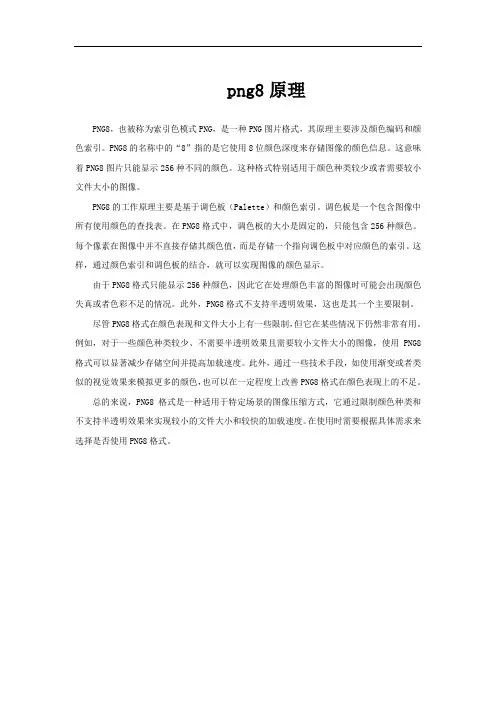
png8原理
PNG8,也被称为索引色模式PNG,是一种PNG图片格式,其原理主要涉及颜色编码和颜色索引。
PNG8的名称中的“8”指的是它使用8位颜色深度来存储图像的颜色信息。
这意味着PNG8图片只能显示256种不同的颜色。
这种格式特别适用于颜色种类较少或者需要较小文件大小的图像。
PNG8的工作原理主要是基于调色板(Palette)和颜色索引。
调色板是一个包含图像中所有使用颜色的查找表。
在PNG8格式中,调色板的大小是固定的,只能包含256种颜色。
每个像素在图像中并不直接存储其颜色值,而是存储一个指向调色板中对应颜色的索引。
这样,通过颜色索引和调色板的结合,就可以实现图像的颜色显示。
由于PNG8格式只能显示256种颜色,因此它在处理颜色丰富的图像时可能会出现颜色失真或者色彩不足的情况。
此外,PNG8格式不支持半透明效果,这也是其一个主要限制。
尽管PNG8格式在颜色表现和文件大小上有一些限制,但它在某些情况下仍然非常有用。
例如,对于一些颜色种类较少、不需要半透明效果且需要较小文件大小的图像,使用PNG8格式可以显著减少存储空间并提高加载速度。
此外,通过一些技术手段,如使用渐变或者类似的视觉效果来模拟更多的颜色,也可以在一定程度上改善PNG8格式在颜色表现上的不足。
总的来说,PNG8格式是一种适用于特定场景的图像压缩方式,它通过限制颜色种类和不支持半透明效果来实现较小的文件大小和较快的加载速度。
在使用时需要根据具体需求来选择是否使用PNG8格式。
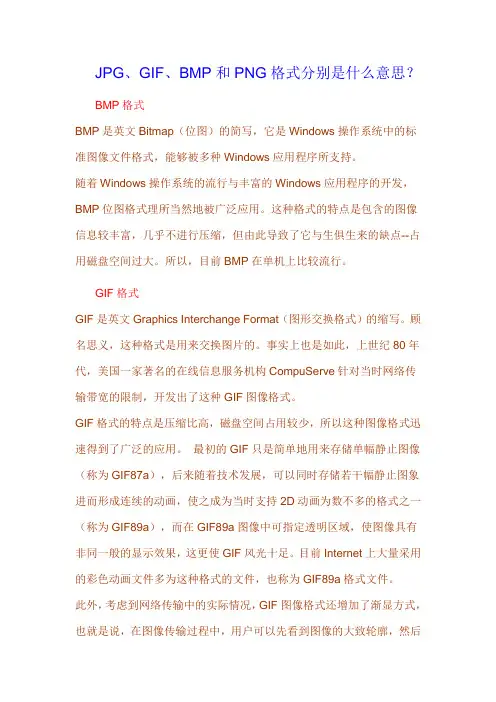
JPG、GIF、BMP和PNG格式分别是什么意思?BMP格式BMP是英文Bitmap(位图)的简写,它是Windows操作系统中的标准图像文件格式,能够被多种Windows应用程序所支持。
随着Windows操作系统的流行与丰富的Windows应用程序的开发,BMP位图格式理所当然地被广泛应用。
这种格式的特点是包含的图像信息较丰富,几乎不进行压缩,但由此导致了它与生俱生来的缺点--占用磁盘空间过大。
所以,目前BMP在单机上比较流行。
GIF格式GIF是英文Graphics Interchange Format(图形交换格式)的缩写。
顾名思义,这种格式是用来交换图片的。
事实上也是如此,上世纪80年代,美国一家著名的在线信息服务机构CompuServe针对当时网络传输带宽的限制,开发出了这种GIF图像格式。
GIF格式的特点是压缩比高,磁盘空间占用较少,所以这种图像格式迅速得到了广泛的应用。
最初的GIF只是简单地用来存储单幅静止图像(称为GIF87a),后来随着技术发展,可以同时存储若干幅静止图象进而形成连续的动画,使之成为当时支持2D动画为数不多的格式之一(称为GIF89a),而在GIF89a图像中可指定透明区域,使图像具有非同一般的显示效果,这更使GIF风光十足。
目前Internet上大量采用的彩色动画文件多为这种格式的文件,也称为GIF89a格式文件。
此外,考虑到网络传输中的实际情况,GIF图像格式还增加了渐显方式,也就是说,在图像传输过程中,用户可以先看到图像的大致轮廓,然后随着传输过程的继续而逐步看清图像中的细节部分,从而适应了用户的"从朦胧到清楚"的观赏心理。
目前Internet上大量采用的彩色动画文件多为这种格式的文件。
GIF格式只能保存最大8位色深的数码图像,所以它最多只能用256色来表现物体,对于色彩复杂的物体它就力不从心了。
尽管如此,这种格式仍在网络上大行其道应用,这和GIF图像文件短小、下载速度快、可用许多具有同样大小的图像文件组成动画等优势是分不开的。
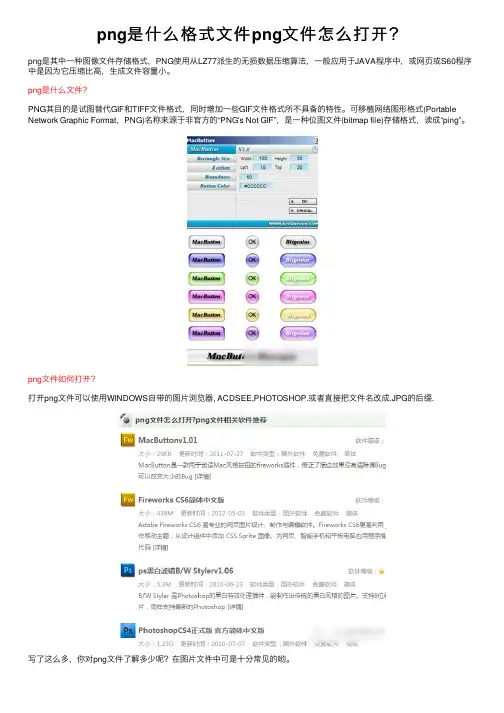
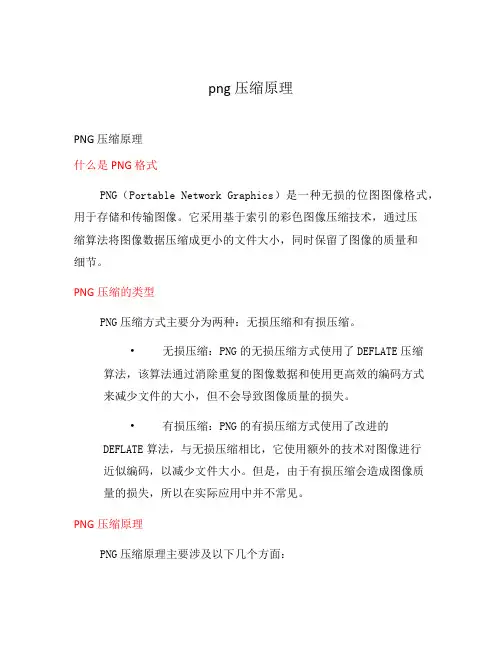
png 压缩原理PNG 压缩原理什么是PNG格式PNG(Portable Network Graphics)是一种无损的位图图像格式,用于存储和传输图像。
它采用基于索引的彩色图像压缩技术,通过压缩算法将图像数据压缩成更小的文件大小,同时保留了图像的质量和细节。
PNG压缩的类型PNG压缩方式主要分为两种:无损压缩和有损压缩。
•无损压缩:PNG的无损压缩方式使用了DEFLATE压缩算法,该算法通过消除重复的图像数据和使用更高效的编码方式来减少文件的大小,但不会导致图像质量的损失。
•有损压缩:PNG的有损压缩方式使用了改进的DEFLATE算法,与无损压缩相比,它使用额外的技术对图像进行近似编码,以减少文件大小。
但是,由于有损压缩会造成图像质量的损失,所以在实际应用中并不常见。
PNG压缩原理PNG压缩原理主要涉及以下几个方面:1. 调色板(Palette)调色板是PNG压缩的重要组成部分,它使用索引颜色的方式来表示图像中的不同颜色。
PNG将图像中的每个颜色映射到一个调色板中的索引值,然后将这些索引值依次保存在文件中,从而减少了存储每个像素的RGB值所需的空间。
2. 无损压缩PNG的无损压缩原理主要基于DEFLATE算法。
DEFLATE算法是一种使用了LZ77算法和哈夫曼编码的无损压缩算法。
它通过识别和替换连续的相同数据块,将这些数据块的出现位置和长度进行压缩,从而减少文件的大小。
3. 滤波器(Filtering)PNG在压缩图像数据之前会先应用一种称为滤波器的技术,该技术可以利用像素之间的相关性来减少数据的冗余度,进而提高压缩效率。
滤波器通过对像素进行预测,并将预测误差保存在文件中,从而减少数据的存储空间。
4. 压缩级别(Compression Level)PNG提供了不同的压缩级别选项,用户可以根据需求选择不同的压缩级别。
较低的压缩级别可以获得较小的文件大小,但可能导致压缩速度较慢;较高的压缩级别可以获得更快的压缩速度,但可能导致文件大小略大。
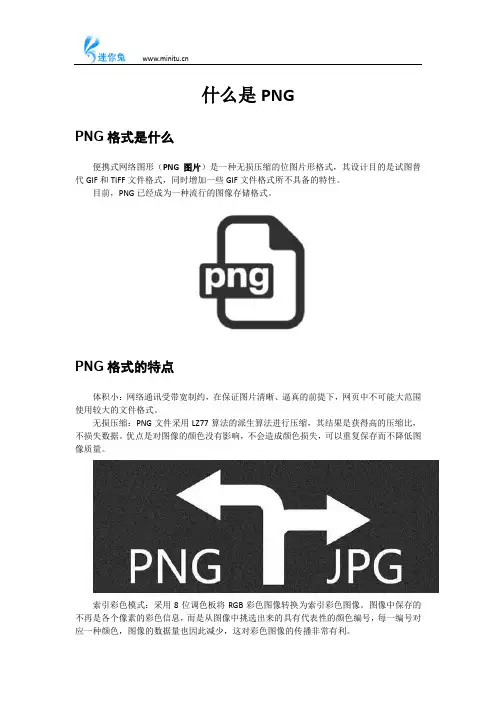
什么是PNGPNG格式是什么便携式网络图形(PNG图片)是一种无损压缩的位图片形格式,其设计目的是试图替代GIF和TIFF文件格式,同时增加一些GIF文件格式所不具备的特性。
目前,PNG已经成为一种流行的图像存储格式。
PNG格式的特点体积小:网络通讯受带宽制约,在保证图片清晰、逼真的前提下,网页中不可能大范围使用较大的文件格式。
无损压缩:PNG文件采用LZ77算法的派生算法进行压缩,其结果是获得高的压缩比,不损失数据。
优点是对图像的颜色没有影响,不会造成颜色损失,可以重复保存而不降低图像质量。
索引彩色模式:采用8位调色板将RGB彩色图像转换为索引彩色图像。
图像中保存的不再是各个像素的彩色信息,而是从图像中挑选出来的具有代表性的颜色编号,每一编号对应一种颜色,图像的数据量也因此减少,这对彩色图像的传播非常有利。
更优化的网络传输显示:PNG图像在浏览器上采用流式浏览,即使经过交错处理的图像会在完全下载之前提供浏览者一个基本的图像内容,然后再逐渐清晰起来。
它允许连续读出和写入图像数据,这个特性很适合于在通信过程中显示和生成图像。
支持透明效果:PNG可以为原图像定义256个透明层次,使得彩色图像的边缘能与任何背景平滑地融合,从而彻底地消除锯齿边缘。
PNG图片的丢失与恢复既然PNG格式的图片如此流行,您有必要知道PNG图片丢失的原因以及必要的恢复方法。
首先,我们来看看PNG图片丢失的常见原因:删除、格式化等操作。
意外丢失,如蓝屏、热插拔、病毒、被工具误清理等。
保存PNG图片的设备出现了故障。
在这种情况下,用什么方法能恢复PNG图片呢?其实,简单的逻辑删除(误删除、格式化、分区丢失等),您可以选择专业的数据恢复工具来进行扫描恢复。
在这里,我们向您推荐迷你兔数据恢复软件。
迷你兔数据恢复软件是一款专业、安全且绿色无插件的工具,能帮助您恢复意外丢失的PNG图片,并且支持电脑、U盘、移动硬盘、内存卡等多种设备,不会对数据造成任何损坏,您可以放心使用。
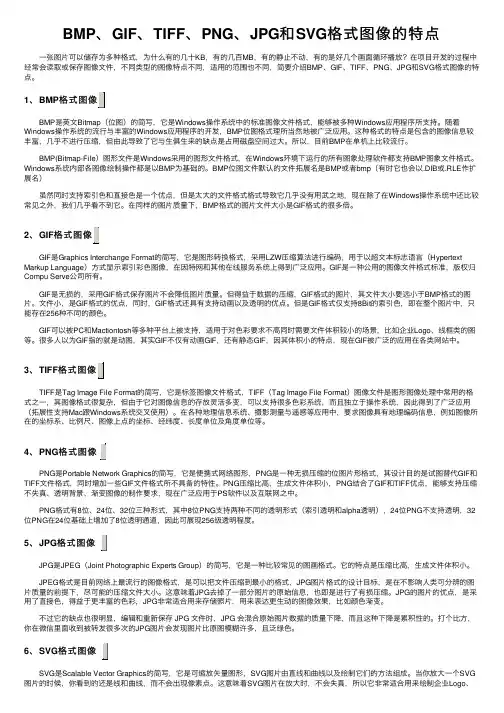
BMP、GIF、TIFF、PNG、JPG和SVG格式图像的特点 ⼀张图⽚可以储存为多种格式,为什么有的⼏⼗KB,有的⼏百MB,有的静⽌不动,有的是好⼏个画⾯循环播放?在项⽬开发的过程中经常会读取或保存图像⽂件,不同类型的图像特点不同,适⽤的范围也不同,简要介绍BMP、GIF、TIFF、PNG、JPG和SVG格式图像的特点。
1、BMP格式图像 BMP是英⽂Bitmap(位图)的简写,它是Windows操作系统中的标准图像⽂件格式,能够被多种Windows应⽤程序所⽀持。
随着Windows操作系统的流⾏与丰富的Windows应⽤程序的开发,BMP位图格式理所当然地被⼴泛应⽤。
这种格式的特点是包含的图像信息较丰富,⼏乎不进⾏压缩,但由此导致了它与⽣俱⽣来的缺点是占⽤磁盘空间过⼤。
所以,⽬前BMP在单机上⽐较流⾏。
BMP(Bitmap-File)图形⽂件是Windows采⽤的图形⽂件格式,在Windows环境下运⾏的所有图象处理软件都⽀持BMP图象⽂件格式。
Windows系统内部各图像绘制操作都是以BMP为基础的。
BMP位图⽂件默认的⽂件拓展名是BMP或者bmp(有时它也会以.DIB或.RLE作扩展名) 虽然同时⽀持索引⾊和直接⾊是⼀个优点,但是太⼤的⽂件格式格式导致它⼏乎没有⽤武之地,现在除了在Windows操作系统中还⽐较常见之外,我们⼏乎看不到它。
在同样的图⽚质量下,BMP格式的图⽚⽂件⼤⼩是GIF格式的很多倍。
2、GIF格式图像 GIF是Graphics Interchange Format的简写,它是图形转换格式,采⽤LZW压缩算法进⾏编码,⽤于以超⽂本标志语⾔(Hypertext Markup Language)⽅式显⽰索引彩⾊图像,在因特⽹和其他在线服务系统上得到⼴泛应⽤。
GIF是⼀种公⽤的图像⽂件格式标准,版权归Compu Serve公司所有。
GIF是⽆损的,采⽤GIF格式保存图⽚不会降低图⽚质量。
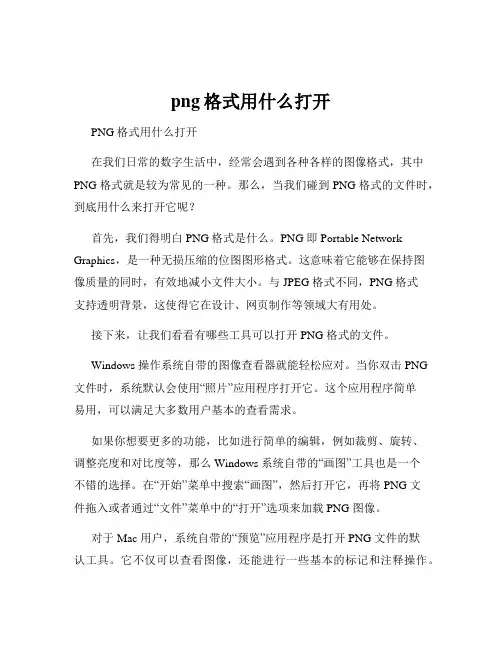
png格式用什么打开PNG 格式用什么打开在我们日常的数字生活中,经常会遇到各种各样的图像格式,其中PNG 格式就是较为常见的一种。
那么,当我们碰到 PNG 格式的文件时,到底用什么来打开它呢?首先,我们得明白 PNG 格式是什么。
PNG 即 Portable Network Graphics,是一种无损压缩的位图图形格式。
这意味着它能够在保持图像质量的同时,有效地减小文件大小。
与 JPEG 格式不同,PNG 格式支持透明背景,这使得它在设计、网页制作等领域大有用处。
接下来,让我们看看有哪些工具可以打开 PNG 格式的文件。
Windows 操作系统自带的图像查看器就能轻松应对。
当你双击 PNG 文件时,系统默认会使用“照片”应用程序打开它。
这个应用程序简单易用,可以满足大多数用户基本的查看需求。
如果你想要更多的功能,比如进行简单的编辑,例如裁剪、旋转、调整亮度和对比度等,那么 Windows 系统自带的“画图”工具也是一个不错的选择。
在“开始”菜单中搜索“画图”,然后打开它,再将 PNG 文件拖入或者通过“文件”菜单中的“打开”选项来加载 PNG 图像。
对于 Mac 用户,系统自带的“预览”应用程序是打开 PNG 文件的默认工具。
它不仅可以查看图像,还能进行一些基本的标记和注释操作。
除了系统自带的工具,还有许多第三方软件可以打开 PNG 格式的文件。
Adobe Photoshop 无疑是图像处理领域的巨头。
它功能强大,能够对PNG 图像进行极其精细的编辑和处理。
无论是调整颜色、添加特效,还是进行复杂的合成操作,Photoshop 都能胜任。
不过,它是一款专业的付费软件,对于普通用户来说,可能有些大材小用。
如果您只是需要一个轻便且免费的图像编辑工具,那么 GIMP 是一个很好的选择。
GIMP 支持多种操作系统,包括 Windows、Mac 和Linux。
它提供了丰富的工具和滤镜,能够满足大多数非专业用户的图像编辑需求。
BMP格式BMP是英文Bitmap(位图)的简写,它是Windows操作系统中的标准图像文件格式,能够被多种Windows应用程序所支持。
随着Windows操作系统的流行与丰富的Windows应用程序的开发,BMP位图格式理所当然地被广泛应用。
这种格式的特点是包含的图像信息较丰富,几乎不进行压缩,但由此导致了它与生俱生来的缺点--占用磁盘空间过大。
所以,目前BMP在单机上比较流行。
GIF格式GIF是英文Graphics Interchange Format(图形交换格式)的缩写。
顾名思义,这种格式是用来交换图片的。
事实上也是如此,上世纪80年代,美国一家著名的在线信息服务机构CompuServe 针对当时网络传输带宽的限制,开发出了这种GIF图像格式。
GIF格式的特点是压缩比高,磁盘空间占用较少,所以这种图像格式迅速得到了广泛的应用。
最初的GIF只是简单地用来存储单幅静止图像(称为GIF87a),后来随着技术发展,可以同时存储若干幅静止图象进而形成连续的动画,使之成为当时支持2D动画为数不多的格式之一(称为GIF89a),而在GIF89a图像中可指定透明区域,使图像具有非同一般的显示效果,这更使GIF风光十足。
目前Internet上大量采用的彩色动画文件多为这种格式的文件,也称为GIF89a格式文件。
此外,考虑到网络传输中的实际情况,GIF图像格式还增加了渐显方式,也就是说,在图像传输过程中,用户可以先看到图像的大致轮廓,然后随着传输过程的继续而逐步看清图像中的细节部分,从而适应了用户的"从朦胧到清楚"的观赏心理。
目前Internet上大量采用的彩色动画文件多为这种格式的文件。
GIF格式只能保存最大8位色深的数码图像,所以它最多只能用256色来表现物体,对于色彩复杂的物体它就力不从心了。
尽管如此,这种格式仍在网络上大行其道应用,这和GIF图像文件短小、下载速度快、可用许多具有同样大小的图像文件组成动画等优势是分不开的。
png格式图片怎么弄PNG 格式图片怎么弄在我们日常的工作、学习和生活中,经常会用到各种图片格式,其中 PNG 格式就是一种常见且实用的图片格式。
那 PNG 格式图片到底怎么弄呢?接下来就让我们一起详细了解一下。
首先,我们要明白什么是 PNG 格式图片。
PNG 即 Portable Network Graphics,是一种支持无损压缩的位图图形格式。
与常见的 JPEG 格式不同,PNG 格式可以保留图像的透明度信息,这使得它在处理需要透明背景的图片时非常有用,比如制作网页图标、设计元素等。
要获取 PNG 格式的图片,常见的方法有以下几种:方法一:使用图像编辑软件制作像 Adobe Photoshop 这样的专业图像编辑软件,是制作 PNG 图片的强大工具。
打开 Photoshop 后,新建一个文档,根据您的需求设置图像的大小、分辨率和颜色模式。
然后进行图像的绘制、编辑,比如添加图形、文字、调整颜色等。
完成编辑后,选择“文件”菜单中的“存储为”,在弹出的对话框中选择“PNG”格式保存即可。
如果您觉得 Photoshop 操作复杂,也可以选择一些相对简单易用的图像编辑软件,如 GIMP、PaintNET 等。
它们的基本操作逻辑与Photoshop 类似,但界面和功能可能会更简洁,适合初学者使用。
方法二:从现有图片转换如果您手头已经有了其他格式的图片,比如 JPEG、BMP 等,想要将其转换为 PNG 格式,也有很多办法。
1、在线转换工具在网上有很多免费的在线图片格式转换工具,您只需要在搜索引擎中输入“图片格式转换”,就能找到大量的相关网站。
打开其中一个网站,上传您要转换的图片,选择输出格式为 PNG,然后等待转换完成并下载即可。
但需要注意的是,选择可靠的在线工具,以确保您的图片信息安全。
2、使用本地软件除了在线工具,您还可以使用本地安装的图片查看器或转换软件来进行格式转换。
例如,Windows 系统自带的“画图”工具就可以实现简单的格式转换。
常用的图片格式:BMP图像文件格式BMP是一种与硬件设备无关的图像文件格式,使用非常广。
它采用位映射存储格式,除了图像深度可选以外,不采用其他任何压缩,因此,BblP文件所占用的空间很大。
BMP文件的图像深度可选lbit、4bit、8bit及24bit。
BMP文件存储数据时,图像的扫描方式是按从左到右、从下到上的顺序。
由于BMP文件格式是Windows环境中交换与图有关的数据的一种标准,因此在Windows 环境中运行的图形图像软件都支持BMP图像格式。
典型的BMP图像文件由三部分组成:位图文件头数据结构,它包含BMP图像文件的类型、显示内容等信息;位图信息数据结构,它包含有BMP图像的宽、高、压缩方法,以及定义颜色等信息。
TIFF图像文件格式TIFF (TaglmageFileFormat)图像文件是由Aldus和Microsoft公司为桌上出版系统研制开发的一种较为通用的图像文件格式。
TIFF格式灵活易变,它又定义了四类不同的格式:TIFF-B 适用于二值图像:TIFF-G适用于黑白灰度图像;TIFF-P适用于带调色板的彩色图像:TIFF-R 适用于RGB真彩图像。
TIFF支持多种编码方法,其中包括RGB无压缩、RLE压缩及JPEG压缩等。
TIFF是现存图像文件格式中最复杂的一种,它具有扩展性、方便性、可改性,可以提供给IBMPC等环境中运行、图像编辑程序。
TIFF图像文件由三个数据结构组成,分别为文件头、一个或多个称为IFD的包含标记指针的目录以及数据本身。
TIFF图像文件中的第一个数据结构称为图像文件头或IFH。
这个结构是一个TIFF文件中唯一的、有固定位置的部分;IFD图像文件目录是一个字节长度可变的信息块,Tag标记是TIFF 文件的核心部分,在图像文件目录中定义了要用的所有图像参数,目录中的每一目录条目就包含图像的一个参数。
GIF文件格式GIF(Graphics Interchange Format)的原义是"图像互换格式",是CompuServe公司在1987年开发的图像文件格式。
Portable Network GraphicsFrom Wikipedia, the free encyclopediaPortable Network GraphicsPNGA PNG image with an 8-bit transparency channel (top). Thesame image is overlaid onto a checkered background(bottom), typically used in graphics software to indicatetransparency.Filenameextension .pngInternet mediatype image/pngType code PNGfPNGpublic.pngUniform TypeIdentifierDeveloped by PNG Development Group (donated to W3C)Initial release October 1, 1996Type of format lossless bitmap imageformat and video codecExtended to APNG, JNG and MNGStandard(s)ISO/IEC15948[1], IETF RFC 2083Open format? YesPortable Network Graphics (PNG, pronounced /ˈpɪŋ/[2]ping) is a bitmapped imageformat and video codec that employs lossless data compression. PNG was created to improve upon and replace GIF (Graphics Interchange Format) as an image-file format not requiringa patent license. The PNG acronym is optionally recursive, unofficially standing for PNG's Not GIF.[2]PNG supports palette-based images (with palettes of 24-bit RGB or32-bit RGBA colors),grayscale images (with or without alpha channel), and RGB[A] images (with or without alpha channel). PNG was designed for transferring images on the Internet, not for print graphics, and therefore does not support non-RGB color spaces such as CMYK.[dubious–discuss] PNG files nearly always use file extension "PNG" or "png" and are assigned MIME media type "image/png"; it was approved for this use by the Internet Engineering Steering Group on October 14, 1996.[3] PNG was published as an ISO/IEC standard in 2004.[1]Contents[hide]∙ 1 History and development∙ 2 PNG Working Group∙ 3 Technical detailso 3.1 File headero 3.2 "Chunks" within the file▪ 3.2.1 Critical chunks▪ 3.2.2 Ancillary chunkso 3.3 Color deptho 3.4 Transparency of imageo 3.5 Compression▪ 3.5.1 Filteringo 3.6 Interlacingo 3.7 Animation∙ 4 Comparison to other file formatso 4.1 Comparison to Graphics Interchange Format (GIF) o 4.2 Comparison to JPEGo 4.3 Comparison to JPEG-LSo 4.4 Comparison to TIFF∙ 5 Software supporto 5.1 Bitmap graphics editor support for PNGo 5.2 Web browser support for PNGo 5.3 Operating system support for PNG icons∙ 6 File size and optimization softwareo 6.1 Compared to GIFo 6.2 File size factorso 6.3 Image editing softwareo 6.4 Optimizing tools▪ 6.4.1 Ancillary chunk removal▪ 6.4.2 Filter optimization▪ 6.4.3 DEFLATE optimization▪ 6.4.4 Wrapper toolso 6.5 Icon optimization∙7 See also∙8 References∙9 Further reading∙10 External linkso10.1 o10.2 W3Co10.3 Others[edit]History and developmentSee also: Graphics Interchange Format#Unisys and LZW patent enforcementThe motivation for creating the PNG format was in early 1995, after it became known thatthe Lempel–Ziv–Welch (LZW) data compression algorithm used in the Graphics InterchangeFormat (GIF) format was patented by Unisys. There were also other problems with the GIF format which made a replacement desirable, notably its limit of 256 colors at a time when computers able to display far more than 256 colors were growing common. Although GIF allows for animation, it was decided that PNG should be a single-image format. A companion format called Multiple-image Network Graphics (MNG) has been defined for animation.A January 1995 precursory discussion thread, on the usenet newsgroup "comp.graphics" with thesubject Thoughts on a GIF-replacement file format, had many propositions, which would later be part of the PNG file format. In this thread, Oliver Fromme, author of thepopular DOSJPEG viewer QPEG, proposed the PING name, meaning PING is not GIF, and also the PNG extension.[4]▪October 1, 1996: Version 1.0 of the PNG specification was released,and later appeared as RFC 2083. It becamea W3C Recommendation on October 1, 1996.▪December 31, 1998: Version 1.1, with some small changes and theaddition of three new chunks, was released.▪August 11, 1999: Version 1.2, adding one extra chunk, was released.▪November 10, 2003: PNG became an International Standard(ISO/IEC 15948:2003). This version of PNG differs only slightlyfrom version 1.2 and adds no new chunks.▪March 3, 2004: ISO/IEC 15948:2004.[1][edit]PNG Working GroupThe original PNG specification was authored by an ad-hoc group of computer graphics experts and enthusiasts. Discussions and decisions about the format were done exclusively via email. The original authors listed on RFC 2083 are:[5]Editor: Thomas Boutell . Contributing Editor: Tom Lane Authors' names in alphabetical order: Mark Adler , Thomas Boutell , Christian Brunschen , Adam M. Costello , Lee Daniel Crocker , Andreas Dilger , Oliver Fromme , Jean-loup Gailly , ChrisHerborth , Alex Jakulin , Neal Kettler , Tom Lane , Alexander Lehmann , Chris Lilley , DaveMartindale , Owen Mortensen , Keith S. Pickens , Robert P. Poole , Glenn Randers-Pehrson , Greg Roelofs , Willem van Schaik , Guy Schalnat , Paul Schmidt , Tim Wegner , Jeremy Wohl[edit ]Technical details[edit ]File headerA PNG file starts with an 8-byte signature . The hexadecimal byte values are 89 50 4E 47 0D 0A 1A 0A ; the decimal values are 137 80 78 71 13 10 26 10. Each of the header bytes is there for a specific reason:[6] Bytes Purpose89 Has the high bit set to detect transmission systems that do not support 8 bit data and to reduce the chance that a text file is mistakenly interpreted as aPNG, or vice versa.50 4E 47 In ASCII , the letters PNG , allowing a person to identify the format easily if it is viewed in a text editor.0D 0A A DOS -style line ending (CRLF) to detect DOS-Unix line ending conversion of thedata.1A A byte that stops display of the file under DOS when the command type has beenused —the end-of-file character0A A Unix-style line ending (LF) to detect Unix-DOS line ending conversion.[edit ]"Chunks" within the fileAfter the header comes a series of chunks, each of which conveys certain information about the image. Chunks declare themselves as critical or ancillary , and a program encountering an ancillary chunk that it does not understand can safely ignore it. This chunk-based storage layer structure, similar in concept to a container format , is designed to allow the PNG format to be extended whilemaintaining compatibility with older versions—it provides forward compatibility, and this same file structure (with different signature and chunks) is used in the associated MNG, JNG,and APNG formats.A chunk consists of four parts: length (4 bytes), chunk type/name (4 bytes), chunk data (length bytes) and CRC (cyclic redundancy code/checksum; 4 bytes).Length Chunk type Chunk data CRC4 bytes 4 bytes Length bytes 4 bytesChunks are given a four letter case sensitive ASCII type/name; compare FourCC. The case of the different letters in the name (bit 5 of the numeric value of the character) is a bit field that provides the decoder with some information on the nature of chunks it does not recognize.The case of the first letter indicates if the chunk is critical or not. If the first letter is uppercase, the chunk is critical; if not, the chunk is ancillary. Critical chunks contain information that is necessary to read the file. If a decoder encounters a critical chunk it does not recognize, it must abort reading the file or supply the user with an appropriate warning.The case of the second letter indicates if the chunk is "public" (either in the specification or the registry of special purpose public chunks) or "private" (not standardised). Uppercase is public and lowercase is private. This ensures that public and private chunk names can never conflict with each other (although two private chunk names could conflict).The third letter must be uppercase to conform to the PNG specification. It is reserved for future expansion. Decoders should treat a chunk with a lower case third letter the same as any other unrecognised chunk.The case of the fourth letter indicates if a chunk is safe to copy by editors that do not recognize it. If lowercase, the chunk may be safely copied regardless of the extent of modifications to the file. If uppercase, it may only be copied if the modifications have not touched any critical chunks. [edit]Critical chunksA decoder must be able to interpret these to read and render a PNG file.▪IHDR must be the first chunk; it contains the header.[7]▪PLTE contains the palette; list of colors.▪IDAT contains the image, which may be split among multiple IDATchunks. Doing so increases filesize slightly, but makes it possibleto generate a PNG in a streaming manner.▪IEND marks the image end.The PLTE chunk is essential for color type 3 (indexed color). It is optional for color types 2 and 6 (truecolor and truecolor with alpha) and it must not appear for color types 0 and 4 (grayscale and grayscale with alpha).[edit]Ancillary chunksOther image attributes that can be stored in PNG files include gamma values, background color, and textual metadata information. PNG also supports color management through the inclusionof ICC color space profiles.[8]▪bKGD gives the default background color. It is intended for usewhen there is no better choice available, such as in standaloneimage viewers (but not web browsers; see below for more details).▪cHRM gives the chromaticity coordinates of thedisplay primaries and white point.▪gAMA specifies gamma.▪hIST can store the histogram, or total amount of each color in theimage.▪iCCP is an ICC color profile.▪iTXt contains UTF-8 text, compressed or not, with anoptional language tag. iTXt chunk with the keyword'XML:com.adobe.xmp' can contain Extensible MetadataPlatform (XMP).▪pHYs holds the intended pixel size and/or aspect ratio of the image.▪sBIT (significant bits) indicates the color-accuracy of the sourcedata.▪sPLT suggests a palette to use if the full range of colors isunavailable.▪sRGB indicates that the standard sRGB color space is used.▪sTER stereo-image indicator chunk for stereoscopic images[9]▪tEXt can store text that can be represented in ISO/IEC 8859-1,with one name=value pair for each chunk.▪tIME stores the time that the image was last changed.▪tRNS contains transparency information. For indexed images, itstores alpha channel values for one or more palette entries. Fortruecolor and grayscale images, it stores a single pixel value thatis to be regarded as fully transparent.▪zTXt contains compressed text with the same limits as tEXt.The lowercase first letter in these chunks indicates that they are not needed for the PNG specification. The lowercase last letter in some chunks indicates that they are safe to copy, even if the application concerned does not understand them.[edit]Color depthPNG color options[10]Bits per pixel Bits per channelColor option Channels 1 2 4 8 16Indexed 1 1 2 4 8Grayscale 1 1 2 4 8 16Grayscale & alpha 2 16 32Truecolor 3 24 48Truecolor & alpha 4 32 64PNG images can either use palette-indexed color or be made up of one or more channels (numerical values directly representing quantities about the pixels). When there is more than one channel in an image all channels have the same number of bits allocated per pixel (known as the bit depth of the channel). Although the PNG specification always talks about the bit depth of channels, most software and users generally talk about the total number of bits per pixel (sometimes also referred to as bit depth or color depth). Since multiple channels can affect a single pixel, the number of bits per pixel is often higher than the number of bits per channel, as shown in the illustration at right.The number of channels will depend on whether the image is grayscale or color and whether it has an alpha channel. PNG allows the following combinations of channels, called the color type.The color type is specified in the color type field, which is a bit field, as explained in the table below at right. Not all combinations are valid, however: there is no indexed grayscale, which would becolor types 1 and 5; transparency in palette images is indicated by the presence of a tRNS chunk, not a separate channel, so there is no color type 7.Name ColortypeBinaryMasksA C PGrayscale 0 0 0 0 0Indexed grayscale 1 0 0 0 1 PaletteTruecolor 2 0 0 1 0 ColorIndexed 3 0 0 1 1 Color | paletteGrayscale & alpha 4 0 1 0 0 AlphaIndexed grayscale & alpha 5 0 1 0 1 Alpha | paletteTruecolor & alpha 6 0 1 1 0 Alpha | colorIndexed & alpha 7 0 1 1 1 Alpha | color | palette▪grayscale▪red, green and blue: rgb/truecolor▪indexed: channel containing indexes into a palette of colors▪grayscale and alpha: level of transparency for each pixel▪red, green, blue and alphaWith indexed color images, the palette is always stored in RGB at a depth of 8 bits per channel (24 bits per palette entry). Additionally, an optional array of 8-bit alpha values of the palette entries may be included. The palette must not have more entries than the image bit depth allows for, but it may have fewer (for example, if an image only uses 90 colors then it does not need palette entries for all 256 colors).Indexed color PNGs are allowed to have 1, 2, 4 or 8 bits per pixel by the standard; grayscale images with no alpha channel allow for 1, 2, 4, 8 or 16 bits per pixel. Everything else uses a bit depth per channel of either 8 or 16. The combinations this allows are given in the table above. The standard requires that decoders can read all supported color formats, but many image editors can only produce a small subset of them.[edit]Transparency of imagePNG offers a variety of transparency options. With truecolor and grayscale images either a single pixel value can be declared as transparent or an alpha channel can be added (enabling any percentage of partial transparency to be used). For paletted images, alpha values can be added to palette entries. The number of such values stored may be less than the total number of palette entries, in which case the remaining entries are considered fully opaque.The scanning of pixel values for binary transparency is supposed to be performed before any color reduction to avoid pixels becoming unintentionally transparent. This is most likely to pose an issue for systems that can decode 16 bits per channel images (as they must to be compliant with the specification) but only output at 8 bits per channel (the norm for all but the highest end systems). [edit]CompressionPNG uses a 2-stage compression process:▪pre-compression: filtering (prediction)▪compression: DEFLATEPNG uses a non-patented lossless data compression method known as DEFLATE, which is the same algorithm used in the zlib compression library.[edit]FilteringPNG's filter method 0 can use the data in pixels A, B, and C to predict the value for X.Before DEFLATE is applied, the data is precompressed, via a prediction method: a single filter method is used for the entire image, while for each image line, a filter type is chosen that transforms the data so that it is hopefully more easily compressed.[11]There is only one filter method in the current PNG specification (denoted method 0), and thus in practice the only choice is which filter type to apply to each line. For this method, the filter predicts the value of each pixel based on the values of previous neighboring pixels, and subtracts the predicted color of the pixel from the actual value, as in DPCM. An image line filtered in this way is often more compressible than the raw image line would be, especially if it is similar to the line above, since the differences from prediction will generally be clustered around 0, rather than spread over all possible image values. This is particularly important in relating separate rows, since DEFLATE has no understanding that an image is a 2D entity, and instead just sees the image data as a stream of bytes.There are five filter types for filter method 0; each type predicts the value of each byte (of the image data before filtering) based on the corresponding byte of the pixel to the left (A), above (B), above and to the left (C) or some combination thereof, and encodes the difference between the predicted value and the actual value. Filters are applied to byte values, not pixels; pixel values may be one or two bytes, or several values per byte, but never cross byte boundaries. The filter types are:[12]Type byte Filter name Predicted value0 None Zero (so that the raw byte value passes through unaltered)1 Sub Byte A (to the left)2 Up Byte B (above)3 Average Mean of bytes A and B, rounded down4 Paeth A, B, or C, whichever is closest to p = A + B−CThe Paeth filter is based on an algorithm by Alan W. Paeth.[13] Compare to the versionof DPCM used in lossless JPEG, and to the discrete wavelet transform using 1×2, 2×1, or (for the Paeth predictor) 2×2 windows and Haar wavelets.Compression is further improved by choosing filter types adaptively on a line-by-line basis. This improvement, and a heuristic method of implementing it commonly used by PNG-writing software,were created by Lee Daniel Crocker, who tested the methods on many images during the creation of the format;[14] the choice of filter is a component of file size optimization, as discussed below.If interlacing is used, each stage of the interlacing is filtered separately, meaning that the image can be progressively rendered as each stage is received; however, interlacing generally makes compression less effective.[edit]InterlacingAn illustration of Adam7 interlacing over a 16×16 image.PNG offers an optional 2-dimensional, 7-pass interlacing scheme—the Adam7 algorithm. This is more sophisticated than GIF's 1-dimensional, 4-pass scheme, and allows a clearer low-resolution image to be visible earlier in the transfer, particularly if interpolation algorithms such as bicubic interpolation are used.[15]However, the 7-pass scheme tends to reduce the data's compressibility more than simpler schemes.[edit]AnimationPNG itself does not support animation at all. MNG is an extension to PNG that does; it was designed by members of the PNG Group. MNG shares PNG's basic structure and chunks, but it is significantly more complex and has a different file signature, which automatically renders it incompatible with standard PNG decoders.The complexity of MNG led to the proposal of APNG by developers of the Mozilla Foundation. It is based on PNG, supports animation and is simpler than MNG. APNG offers fallback to single-image display for PNG decoders that do not support APNG. However, neither of these formats is currently widely supported. APNG is supported in Firefox3.0 and Opera 9.5.[16] The PNG Group decided in April 2007 not to embrace APNG.[17] Several alternatives were under discussion, ANG,aNIM/mPNG, ―PNG in GIF‖ and its subset ―RGBA in GIF‖.[18][edit]Comparison to other file formats[edit]Comparison to Graphics Interchange Format (GIF)▪On small images, GIF can achieve greater compression than PNG(see the section on filesize, below).▪On most images, except for the above cases, GIF will be bigger thanindexed PNG.▪PNG gives a much wider range of transparency options than GIF,including alpha channel transparency.▪Whereas GIF is limited to 8-bit indexed color, PNG gives a muchwider range of color depths, including 24-bit (8 bits per channel)and 48-bit (16 bits per channel) truecolor, allowing for greatercolor precision, smoother fades, etc.[19] When an alpha channel isadded, up to 64 bits per pixel (before compression) are possible.▪GIF intrinsically supports animated images. PNG supports animationonly via unofficial extensions (see the section on animation,above).▪PNG images are less widely supported (e.g. older web browsers andoffice software).[20]▪Silverlight supports PNG but has opted not to support GIF.[21] [edit]Comparison to JPEGComposite image comparing JPEG and PNG: notice artifacts in JPEG versus solid PNG background. JPEG (Joint Photographic Experts Group) can produce a smaller file than PNGfor photographic (and photo-like) images, since JPEG uses a lossy encoding method specifically designed for photographic image data, which is typically dominated by soft, low-contrast transitions, and an amount of noise or similar irregular structures. Using PNG instead of a high-quality JPEG for such images would result in a large increase in filesize (often 5–10 times) with negligible gain in quality. By contrast, when storing images that contain text, line art, or graphics – images with sharp transitions and large areas of solid color – the PNG format can compress image data more than JPEG can, and without the noticeable visual artifacts which JPEG produces around high-contrastareas. Where an image contains both sharp transitions and photographic parts a choice must be made between the two effects. Note that JPEG does not support transparency.Also, JPEG suffers from generation loss (repeatedly encoding and decoding an image with JPEG will degrade its quality), whereas lossless formats such as PNG do not. Since PNG is extremely inefficient in compressing photographs, sometimes a lossless compression format designed for photographic images – such as lossless JPEG 2000, or Adobe DNG (Digital negative) – is used for storing photographs which might require further editing. When the photograph is finally ready to be distributed, it can then be saved as a JPEG: a single pass of high-quality JPEG encoding will not noticeably degrade a photographic image. Furthermore, PNG does not provide a standard means of embedding Exif image data from sources such as digital cameras, which makes it problematic for use amongst photographers, especially professionals. TIFF, JPEG 2000, and DNG do support such meta data.JPEG has historically been the format of choice for exporting images containing gradients, as it could handle the color depth much better than the GIF format. However, any compression by the JPEG would cause the gradient to become blurry, but a 24-bit PNG export of a gradient image often comes out identical to the source image, and at a small file size. As such, the PNG format is the optimal choice for exporting small, repeating gradients for web usage.[edit]Comparison to JPEG-LSJPEG-LS is a "near-lossless" image format by the Joint Photographic Experts Group, though far less widely known and supported than the other lossy JPEG format discussed above. It is directly comparable with PNG,[clarification needed] and has a standard set of test images.[citation needed] On these images, JPEG-LS generally performs better than PNG, by 10–15%, but on some images PNG performs substantially better, on the order of 50–75%.[22] Thus, if both of these formats are options and file size is an important criterion, they should both be considered, depending on the image. [edit]Comparison to TIFFTagged Image File Format (TIFF) is a format that incorporates an extremely wide range of options. While this makes TIFF useful as a generic format for interchange between professional image editing applications, it makes adding support for it to applications a much bigger task and so it has little support in applications not concerned with image manipulation (such as web browsers). It also means that many applications can read only a subset of TIFF types, creating more potential user confusion.The most common general-purpose, lossless compression algorithm used with TIFFis Lempel–Ziv–Welch (LZW). This compression technique, also used in GIF, was covered by patents until 2003. There is a TIFF variant that uses the same compression algorithm as PNG uses, but it is not supported by many proprietary programs. TIFF also offers special-purpose losslesscompression algorithms like CCITT Group IV, which can compress bilevel images (e.g., faxes or black-and-white text) better than PNG's compression algorithm.[edit]Software support[edit]Bitmap graphics editor support for PNGMain article: Comparison of raster graphics editorsPopular graphics programs which support the PNG format include AdobePhotoshop, Corel's Photo-Paint and Paint Shop Pro, the GIMP,GraphicConverter, HeliconFilter, Inkscape, IrfanView, Konvertor, Universal Converter, Pixel image editor, and Xara. Some programs bundled with popular operating systems which support PNGinclude Microsoft's Paint and Apple's iPhoto and Preview, with the GIMP also often being bundled with popular Linux distributions.Adobe Fireworks (formerly by Macromedia) uses PNG as its native file format, allowing other image editors and preview utilities to view the flattened image. However, Fireworks by default also stores meta data for layers, animation, vector data, text and effects. Such files should not be distributed directly. Fireworks can instead export the image as an optimized PNG without the extra meta data for use on web pages, etc.[23]Some image processing programs have PNG compression problems, mainly related to lack of full implementation of the PNG compressor library.[citation needed] These include:▪Microsoft's Paint for Windows XP▪Microsoft Picture It! Photo Premium 9▪older versions of Adobe Photoshop.Adobe's Fireworks is sometimes placed in this category, but its difficulties are less severe than the other entries. The confusion stems from a misunderstanding of the mechanics of its Save format: though PNGs, the intermediate images produced by that option include large, private chunks containing complete layer and vector information, which allows further, lossless editing. Properly saved with the Export option, Fireworks' PNGs are competitive with those produced by other image editors, but are no longer editable as anything but flattened bitmaps. Fireworks is unable to save size-optimized vector-editable PNGs.[edit]Web browser support for PNGMain article: Web browser image format supportPNG support first appeared in Internet Explorer 4.0b1 and in Netscape 4.04.[24]Despite calls by the Free Software Foundation[25] and the World Wide WebConsortium (W3C),[26] tools such as gif2png,[27] and campaigns such as burn all gifs,[28] PNG adoption on websites has been fairly slow.[citation needed]GIF is found to be in use more than PNG for a few reasons:▪No support on old browsers (such as Internet Explorer below version4).▪No animation, still images only (unlike GIF, though Mozilla'sunofficial APNG format is a potential solution).PNG compatible browsers include: Apple Safari, Google Chrome, MozillaFirefox, Opera, Camino, Internet Explorer 7 (still numerous issues),[29]Internet Explorer8 (improved) and many others. For the complete comparison, see Comparison of web browsers (Image format support).However, Internet Explorer (Windows), has numerous problems which prevent it from correctly rendering PNG images.[29]▪4.0 crashes on large PNG chunks.[30]▪4.0 does not include the functionality to view .png files,[31] but there isa registry fix.[29]▪5.0 and 5.01 have broken OBJECT support.[32]▪5.01 prints palette images with black (or dark gray) backgroundsunder Windows 98, sometimes with radically altered colors.[33]▪6.0 fails to display PNG images of 4097 or 4098 bytes in size.[34][35]▪6.0 cannot open a PNG file that contains one or more zero-lengthIDAT chunks. This issue was first fixed in security update 947864(MS08-024). For more information, see this article in the MicrosoftKnowledge Base: 947864 MS08-024: Cumulative Security Updatefor Internet Explorer [36]▪6.0 sometimes completely loses ability to display PNGs, but there arevarious fixes.[34]▪6.0 and below has broken alpha-channel transparency support (willdisplay the default background color instead).[37][38][39] Howeverthere are various fixes:▪Degradable PNG Transparency for IE6▪webfx - PNG Behavior (IE behavior/.htc)▪The PNG problem in Windows Internet Explorer (IEbehavior/.htc) (unmaintained)。
常见图⽚格式分析-bmp,png⼀、bmp图⽚①单⾊位图:每个像素最多可以表⽰2种颜⾊,只需要使⽤长度为1的⼆进制位来表⽰,因此每个像素占1/8byte② 16⾊位图:每个像素最多可以表⽰16种颜⾊,只需要长度为4(2^4=16)的⼆进制表⽰,每个像素占1/2byte③ 256⾊位图:每个像素最多表⽰256种颜⾊,需要长度为8(2^8=256)的⼆进制表⽰,每个像素占1byte④ 24位位图:即RGB三原⾊位图,每个像素占24位,3个byteps:⼀字节(1byte)=8位(8bit)图形的⼤⼩ = 图⽚的总像素*每个像素的⼤⼩,图⽚的总像素 = 图⽚长*⾼bmp图⽚格式:①位图⽂件头bmfh(占14个字节):数据结构如下:typedef struct tagBITMAPFILEHEADER {WORD bfType; //类型名,字符串“BM”,占2个字节,DWORD bfSize; //⽂件⼤⼩,占4个字节WORD bfReserved1; //保留字,占2个字节WORD bfReserved2; //保留字,占2个字节DWORD bfOffBits; //实际位图数据的偏移字节数,即前三个部分长度之和,占4个字节} BITMAPFILEHEADER;②位图信息头bmih(占40个字节)typedef struct tagBITMAPINFOHEADER{DWORD biSize; //指定此结构体的长度,0x28LONG biWidth; //位图宽LONG biHeight; //位图⾼.为正,表⽰从下往上存储,左下⾓是起点。
为负,表⽰从上往下储存,左上⾓是起点 WORD biPlanes; //平⾯数,为1WORD biBitCount //采⽤颜⾊位数,可以是1,2,4,8,16,24,32DWORD biCompression; //压缩⽅式,可以是0,1,2,其中0表⽰不压缩DWORD biSizeImage; //实际位图数据占⽤的字节数LONG biXPelsPerMeter; //X⽅向分辨率LONG biYPelsPerMeter; //Y⽅向分辨率DWORD biClrUsed; //使⽤的颜⾊数,如果为0,则表⽰默认值(2^颜⾊位数)DWORD biClrImportant; //重要颜⾊数,如果为0,则表⽰所有颜⾊都是重要的} BITMAPINFOHEADER;③彩⾊表aColors单⾊位图彩⾊表占8字节16⾊位图彩⾊表占64字节256⾊位图彩⾊表占1024字节⼆、png图⽚png图⽚格式:由8个字节的PNG⽂件署名和数据块组成png⽂件署名域:89 50 4e 47 0d 0a 1a 0a (固定)IHDR数据块:00 00 00 0d(说明IHDR头块长度为13)49 48 44 52(IHDR的hex值)00 00 00 64(图像的宽,这⾥为100像素)00 00 00 4f(图像的⾼,这⾥为79像素)08 表⽰⾊深 02 表⽰颜⾊类型 00 预留 00 预留 00 ⾮隔⾏扫描92 eb f7 f6(CRC校验)※这⾥需要注意的是图像的宽、⾼数据,ctf题⽬经常将修改宽⾼后的图⽚作为题⽬来隐藏信息最后得有个IEND数据块,通常值为 00 00 00 00 49 45 4E 44 AE 42 60 82在IEND块后⾯添加任何的字符都对⽂件的打开造成不了影响,那我们就可以在这⾥藏⼀些数据了。
毕业论文图片格式毕业论文图片格式在撰写毕业论文的过程中,图片是不可或缺的一部分。
图片可以用来支持论文中的观点、提供数据分析结果、解释实验过程等。
然而,对于毕业论文中的图片格式,很多人可能并不十分了解。
本文将探讨毕业论文中常用的图片格式,并分析它们的优缺点。
一、JPEG格式JPEG(Joint Photographic Experts Group)是一种广泛应用于数字图像压缩的格式。
它可以将图像压缩到较小的文件大小,同时保持相对较高的图像质量。
因此,JPEG格式常常被用于存储照片、插图等大量颜色丰富的图像。
然而,JPEG格式也存在一些缺点。
由于压缩算法的特性,JPEG格式在图像压缩的过程中会丢失一部分细节,尤其是在高压缩比下。
因此,如果需要在论文中展示细节丰富的图片,如实验结果的曲线图或者实物的细节图,使用JPEG格式可能不太适合。
二、PNG格式PNG(Portable Network Graphics)是一种无损压缩的图片格式。
与JPEG不同,PNG格式在压缩图像时不会丢失任何细节,因此适合用于保存需要保持高质量的图片。
PNG格式的另一个优点是支持透明背景。
在论文中,有时需要将图片与文字或其他图像进行叠加,为了使叠加效果更好,可以选择使用PNG格式的图片。
然而,PNG格式的文件大小通常比JPEG格式大,尤其是对于颜色丰富的图像。
因此,在论文中使用PNG格式的图片时,需要注意文件大小的控制,以免影响论文的加载速度。
三、TIFF格式TIFF(Tagged Image File Format)是一种高质量的无损压缩格式。
它可以保存图像的所有细节,并且支持多种颜色模式和色彩深度。
因此,对于需要保持高质量的图片,如研究中的显微镜图像或者实验结果的高分辨率图像,TIFF格式是一个不错的选择。
然而,TIFF格式的文件大小通常比JPEG和PNG更大,因此在使用TIFF格式的图片时,同样需要注意文件大小的控制。
四、SVG格式SVG(Scalable Vector Graphics)是一种基于XML的矢量图形格式。